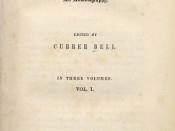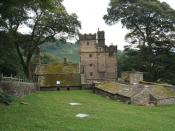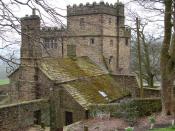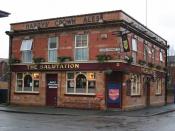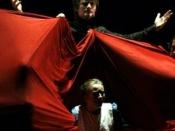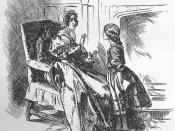With today's vast knowledge of literary techniques and the wide social acceptance of the majority of ideas portrayed in texts, it is possible to deconstruct a text, based on the 4 reading approaches. Each approach; world context centered, text centered, reader centered and author centered; symbolise a time in history when various methods of analysing a text were favored. These approaches have continued on into modern society, enabling analysis of texts through an integration of the reading methods or singular use. Perhaps the most modern analysis technique is the world context centered approach. It aims to uncover those silenced in a text and establish awareness to imperative issues surrounding cultural, gender, sexuality and ethnicity marginalisation. The world context approach is popular within many modern literary circles based on the inclination for equality. The text centered approach concentrates on the use of the expression, language and techniques in the text to deduce a reading.
It dismisses the idea that the author, reader, time or culture may have any relevance in the meaning, value or importance of the text. The reader-centered approach is produced around the belief that the reader has sole domination over their implications of the text primarily through their prior knowledge, experience and acceptance. Alternatively, the author-centered approach considers the author and draws parallels between their background and the text. By analysis of a popular 'classic' Jane Eyre by Charlotte Bronte, it is possible to construct two different readings by considering the author centered approach and the reader centered approach. These analyses demonstrate how an audience can be positioned depending on the approach taken when both reading and considering the elements in the text. Considered a 'fictional autobiography', Jane Eyre provides readers with the life story of Jane- the fictional main character. Jane, a "victim of charity" (http://www.umd.umich.edu) is orphaned when both parents "died within a month of each other" due to Typhus Fever. She is sent to live with wealthy relatives who abuse her position and dislike her qualities, which result in her being moved to Lowood School. Jane survives her harsh and unjust treatment as a pupil and graduates to teaching at Lowood, but soon escapes and becomes a governess in Rochester's Thornfield Hall. After falling in love with Mr. Rochester, Jane accepts his marriage proposal, only to discover his marital status, nearly leading to his bigamy and she flees his grasp. Jane wanders the merciless countryside and eventually finds a compassionate family unit to receive her. She discovers that St John Rivers and his two sisters are actually her cousins after inheriting a large estate from their uncle. Jane almost accepts St John River's marriage proposal and position as his missionary wife, but realizes her eternal love for Mr. Rochester. Upon regaining contact with the recently blinded and crippled Mr. Rochester, Jane accepts his proposal once more and they are quietly wed. Further examination of the story can establish that different readings are enabled through distinct reading methods.
An author-centered analysis of Jane Eyre provides evidence that the novel has marked similarities to the life and belief systems of Charlotte Bronte and the time frame in which she worked. The mimetic elements in Jane Eyre leave the audience with the impression that although it is supposedly fictional, certain elements Bronte included in the text construct a realistic autobiography. Jane Eyre can be considered to emulate Bronte's life through the delineation of the characters, settings and proceedings in the account of Jane's life. Bronte's unconsidered partiality toward characters and circumstances reveal her personal reactions to similar elements of her life. Her positioning on certain aspects within the text are created through her education, family life, intrinsic cultural and personal belief systems and society's reactions to contradictory ideas. Considered an experimental and unacceptable book upon production, due to the radical extention beyond existent ideology of the time, Jane Eyre confirms Bronte's desire to resist conventional conduct and philosophies of her society. Bronte endeavored to create a story that truly expressed her opinions and attitudes without censorship by a society reluctant to accept disparate concepts. One theory of explaining how the author determines the meaning of the text, is the three levels of ideology. It discusses what influences a writer to construct a text, and enables a reader to deconstruct a meaning from the text. The first level of ideology is the "explicit social, political or moral belief of the individual writer." (P. Hollindale, Ideology and the Children's Book) It surrounds the desire to intentionally proselytsise their audience to succumb to a certain set of beliefs. The second level of ideology is known as "passive ideology" (P. Hollingdale, Ideology and the Children's Book) where the author's unrealised inner opinions position the reader to agree with the dominant ideology. The third level of ideology encompasses the world- view and the difference between alternate societies and cultures, where each writer is manipulated to construct their text within the paradigm's placed within the social and literary order.
Parallels between Eyre's and Bronte's lives can be established recurrently throughout the both traceable and tractable storyline. Bronte conspicuously scatters the text with vivid depictions of characters, relationships and places significantly similar to those in her own life. Her father raised Bronte, along with her 5 siblings, after her mother's death due to cancer. Charlotte and her siblings "brought themselves up" (Class handout #8, Charlotte Bronte) in the inhospitable town of Howarth, on the Yorkshire moors. An emotional resemblance can be seen in Jane Eyre when Jane is orphaned when both parents "died within a month of each other" due to Typhus Fever. Charlotte possibly felt little connection to her father and considered herself an emotional orphan. Charlotte, along with her sisters Maria, Elizabeth and Emily were sent to Cowan Bridge School, which is considered the life- like equivalent of Lowood School in Jane Eyre. Charlotte's elder sister Maria is emulated in Helen Burns, an orphan at Lowood who befriends Jane. Maria attempted to teach her sisters to read and write and despite her pleasant disposition, she endured many hardships and died soon after entering Cowan Bridge School. Her death was heartbreaking for Charlotte and this pain was reflected in the death of Helen Burns who claimed that according to Christ: "love your enemies; bless them that curse you; do good to them that hate you and despitefully use you" Helen, like Maria was a self-sacrificial and intellectual being, of whom both Jane and Charlotte modelled themselves upon. Already at this young age, Bronte depicted Jane as a strong character with intense personal opinions. Charlotte shows her defiance of society and it's rigorous beliefs with Jane's abrupt statement of those in positions of power: "If people were always kind and obedient to those who are cruel and unjust, the wicked people would have it all their own way; they would never feel afraid, and so they would never alter, but would grow worse and worse. When we are struck at without a reason, we should strike back again very hard; I am sure we should-so hard as to teach the person who struck us never to do it again." Charlotte became a proficient pupil, and went on to teach at Miss Wooler's School in 1935. Jane became a teacher at Lowood and both soon moved on to become Governesses. Jane's stance against Mr Rochester invalid marriage proposal, indicates her wish for self sacrifice, especially in terms of love. Charlotte is voicing the dominant view of the time on the unacceptability of the act of bigamy. Jane escapes Mr Rochester's love and becomes a part of another community entirely. Here she becomes the sole governess of a small school, connoting Charlotte's wish to own a school. Jane, like Charlotte is described as a "plain, Quakerish governess," additional to their poverty, making finding a husband problematic. Charlotte voices her wish for blind love through Mr Rochester who is undeniably in love with Jane, despite her negative traits. Charlotte expressed this blind love through Mr Rochester's symbolic loss of vision. This occurrence could also be an indication of resuming both a physical and emotional contact with her father after a length and his sudden eye operation, which happened as Jane was completing the novel. Jane's final consent to marry Mr Rochester establishes the idea that Charlotte was unconcerned as to societies views on the matter and her joyous lapse into self worth and the need for love.
On the alternate view of text analysis, the reader centred approach is established around the views the audience, or reader holds on the text and the ideas it portrays. Throughout history there has been a marked shift in the 'Horizon of Expectation;' when the ideas, methodology, discourses and belief systems are reconsidered, analysed and judged, depending on the society, time frame and personal opinions of the reader. These unavoidable transformations will continue into the future, leaving behind many theories, beliefs and thoughts surrounding a text. Reader centred readings are made on the readers education, language, personal preferences and literary competence. Due to differing social opinion and the shift in the 'Horizon of Expectation,' many literary criticisms and resistant readings are apparent within the novel's audience. These can be due to the realisation for equality, which is not shared throughout the text or contradictory personal or social values and belief systems to that of the text. Through the change in the 'Horizon of Expectation,' readers have grown to examine and question, sooner than accept the readings and the meanings of the text. Hans Robert Jauss developed Reception Theory in an attempt to allow acceptance of the reader's personal analysis of a text. It involves the Reader- Response criticism which analyses the reader and his/ her reading approaches in relation to the meaning the text evokes within.
History has shown through a text like Jane Eyre the differing opinions readers' place on texts through their individual reading and interpreting devices. Personally, Jane Eyre was a beautifully written, descriptive text with didactic overtones that effectively served their purpose. I enjoyed using the language to construct mental images of the scenes depicted in the text and the leisurely movement of the story line. Despite the fact that I thoroughly enjoyed the book, alternate readings of the are already apparent. I considered the book relatively slow moving, whilst it was written in a time when society considered it "fast paced." I felt a certain similarity of emotions towards the key characters as Charlotte intended, probably due to the fact that during reading of the text I resigned myself to a frame of mind mirroring Bronte's herself, ignoring my modern day translations and interpretations on many levels. I considered both Jane and Helen Burns amiable characters although their want for self sacrifice annoyed me somewhat. I felt a certain distance from the two characters on this level, probably due to my atheist upbringing, especially with Helen's words: "love your enemies; bless them that curse you; do good to them that hate you and despitefully use you" and "the Bible bids us return good for evil." Despite Mr Rochester's fiery temper and lack of good looks, I found him an attractive character, in accordance with both Charlotte and Jane. I considered Jane's decision to leave Mr Rochester, ultimately due to the fear of the views society would hold on her, a decision that I would personally not take, as I regard self worth and enjoyment of life above any religious belief or view that society holds. Regardless of my view on the novel, It can be seen how the reader's background ultimately positions the reader to a certain stance on the various aspects of the text.
Through the four reading approaches and the various literary theories relating to their use, it is possible to see that different readings can be produced surrounding a text. Jane Eyre is a classic tale that holds many discourses, of which origins can be traced back to the author, Charlotte Bronte. Reader opinion and ideas accumulated from the text can also be formed in the various reading approaches and background of the reader. The novel is held highly as a literary source and can therefore be publicly used as an example of reading positions.
